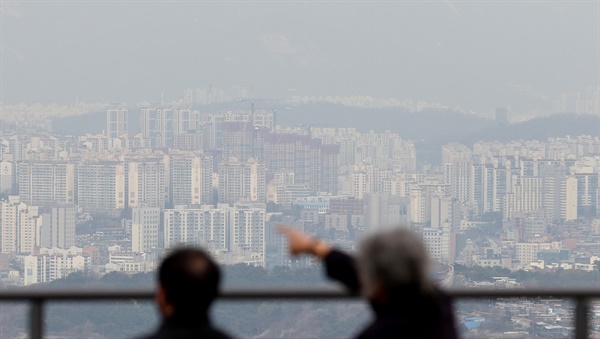|
View larger picture |
|
| ▲ Minister of Land, Infrastructure and Transport Byun Chang-heum speaks at a party-political discussion on a plan to dramatically expand the supply of housing in metropolitan areas held at the Assembly Hall of the National Assembly on the 4th. | |
| Ⓒ Joint coverage photo |
View related photos |
The government promotes reconstruction and redevelopment projects directly implemented by the public to increase housing supply in large cities such as Seoul. In addition, it decided to increase the profits to land owners, such as raising the floor area ratio, than the existing projects, and to activate the housing supply through a method that guarantees profits by the government.
On the 4th, the government announced a 2·4 housing supply measure called’Public Gongjudo 3080+’. The big picture of the measure is that it will secure a site by 2025 that can build 836,000 houses, including 616,000 in the metropolitan area and 220,000 in the local area.
The key is urban dense development and guaranteeing land owners’ interests. The government decided to proceed with the urban public housing complex project for the next three years. The station area (more than 5000㎡) is divided into residential and commercial high-density districts, semi-industrial areas (more than 5000㎡) are residential-industrial convergence districts, and low-rise residential areas (over 10,000㎡) are divided into housing supply activation districts. Among the 836,000 supply plans announced by the government, 573,000 are included here.
570,000 units supplied through downtown development
In all, the government guarantees the return of the landowners. In this measure, the government stated that it would guarantee a higher rate of return (10-30%p) to landowners than existing projects. In addition, it was decided to first supply apartments and shopping malls to land owners. It introduces a method of paying the pre-sale price to be paid by the landlord in kind and settling it as an existing asset, and also exempts the transfer tax.
If this plan is followed, dense development is possible by applying floor area ratio and ease of mining standards. In the case of the station area, it was decided to increase the floor area ratio up to 700%, and to lower the ratio of commercial facilities. For low-rise residential areas, building-related regulations such as lighting and height standards are relaxed, allowing high-rise buildings to be built.
The pace of business is expected to be unprecedented. The so-called public-led fast track is applied. If more than 66% of the landowners agree within one year in the planned area, the project will be confirmed, and the development project will be approved quickly through integrated deliberation. The government’s goal is to shorten the average duration of maintenance projects from 13 to 5 years.
It is expected to supply about 136,000 units through a maintenance project directly implemented by the public. This is a method in which public institutions such as LH and SH Corporation directly implement redevelopment and reconstruction projects with the consent of residents. Members participating in this project are also beneficiaries of this measure.
Public reconstruction and reconstruction excess profit return system are not applied
|
View larger picture |
|
| ▲ The photo shows an apartment under construction in Wirye New Town as seen from Namhansanseong in Gwangju, Gyeonggi-do on the morning of the 24th. 2021.1.24 | |
| Ⓒ Yonhap News |
View related photos |
First of all, the reconstruction excess profit return system is exempted, and the 2-year residency obligation for reconstruction members is also not applied. For the project site, the first step is increased, but it is increased to 120% of the legal floor area ratio. For members, additional profits (10~30%p) compared to the existing maintenance plan are guaranteed.
The Ministry of Land, Infrastructure and Transport said, “In addition to the guaranteed additional income, development profits will be used to improve the urban environment, such as providing a means of living for real residents without cost burden, support for immigration and livelihoods for tenants and small merchants, and expansion of SOC for living in local communities.”
15~20 public housing maps nationwide were newly designated, supplying 263,000 units, and 30,000 units were built by supplementing the function of improving old residential areas of the urban regeneration project. It will supply about 101,000 units by securing as many houses as possible in the city center for quick occupancy.
The government has decided to supply more than 70-80% of the volume determined in this measure as pre-sale housing. It said that it would expand the supply of public pre-sale housing, which is cheaper than the market price, but did not specify how cheap it is compared to the market price.
A new lottery system will be introduced for the amount of housing supplied by this measure. It was decided to select tenants (members of homeless households for 3 years or more) by lottery with 30% for exclusive use under 85㎡ and 50% for exclusive use over 85㎡.
The Ministry of Land, Infrastructure and Transport insisted, “It is possible to prevent undeveloped development through a structure that allows the Ministry of Land, Infrastructure or local governments to designate districts and directly implement them or to enable private projects to be activated under the preliminary plan.”


